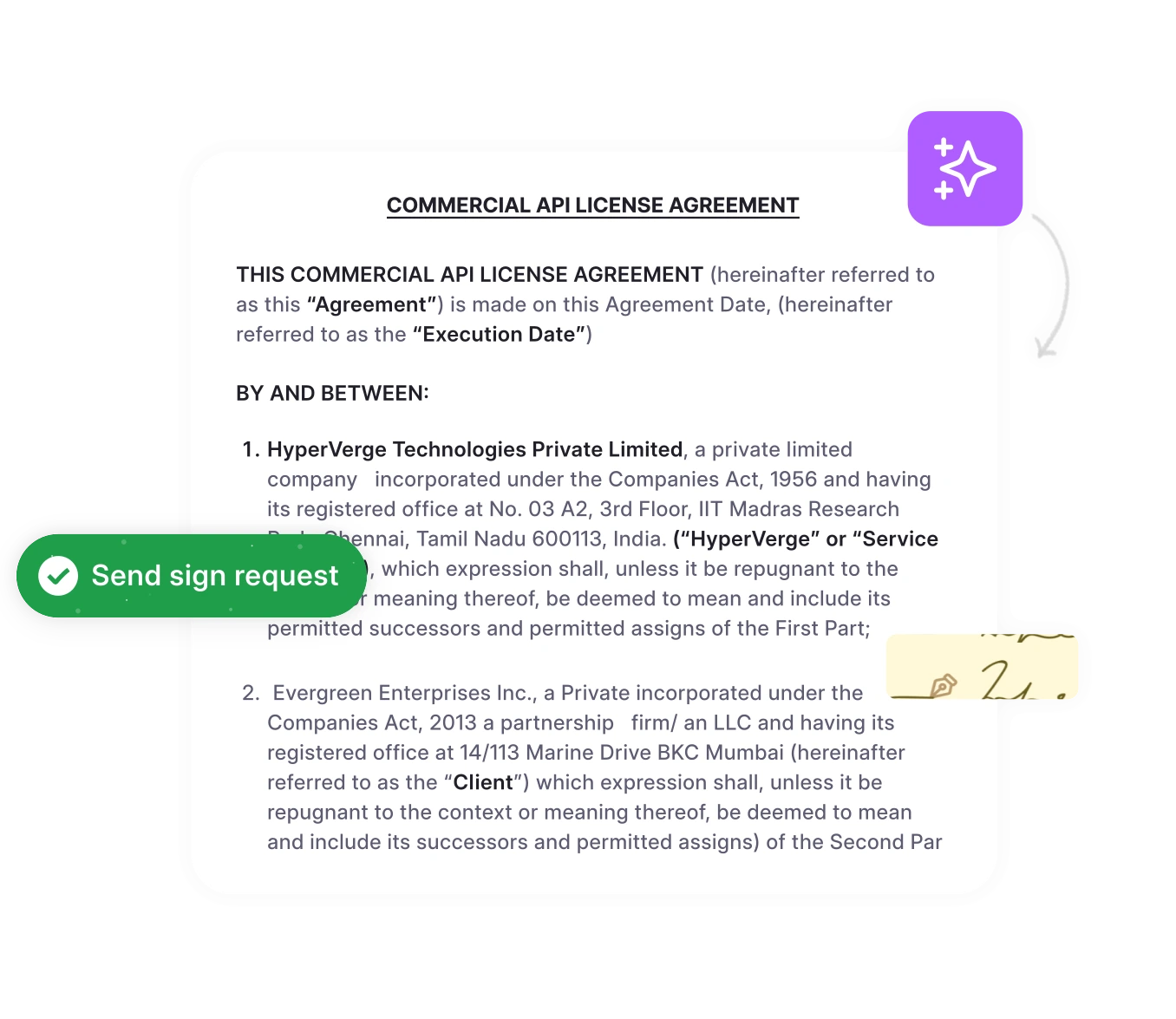When a single invalid provision threatens to render unenforceable the entire agreement, a well-drafted severability clause ensures the remaining provisions hereof remain valid under applicable law. Such clauses protect the parties hereto and preserve business relationships in good faith.
Legal teams managing hundreds of agreements know that one unenforceable clause can create cascading risks across their contract portfolio. According to the US Chamber of Commerce, businesses globally spend approximately $870 billion annually on dispute resolution and liability costs from commercial claims.
A well-drafted severability clause acts as your safety net, preserving the validity of your agreement even when specific provisions fail. This guide provides the definition, comprehensive examples across industries, and practical drafting guidance to help you implement severability clauses that protect your contracts from complete invalidation while maintaining smooth contract creation workflows.
What is a severability clause?
A severability clause is a contractual provision stating that if any part of an agreement becomes invalid or unenforceable, the remaining provisions continue in full effect. This contract clause prevents a single problematic provision from nullifying the entire contract. Courts can “sever” the invalid portion while preserving the parties’ overall agreement.
The clause serves as essential insurance for maintaining an enforceable contract. When regulations change or courts strike down specific contract terms, the severability provision ensures your core agreement survives.
With contract disputes representing 64% of all U.S. civil lawsuits, severability provisions have become critical risk management tools. Most commercial contracts include severability clauses to protect against unforeseen legal challenges and maintain business relationships despite partial invalidity.
Examples of the severability clause in business contracts
Understanding how severability clauses work requires examining real-world examples across different contexts. The following sections provide comprehensive severability clause samples organized by type, industry, and jurisdiction. These examples range from basic templates suitable for simple agreements to sophisticated provisions designed for complex international transactions.
Settlement agreements are prime examples of contracts where severability ensures that invalid clauses don’t void the entire deal. See how here: Settlement Agreement Template.
Part A: Standard severability clause samples
Every severability clause follows one of four fundamental approaches to handling invalid provisions. The choice between these variations depends on your agreement’s complexity and how much flexibility you want courts to have when addressing problematic terms.
Table: Basic Severability Clause Variations
| Type | Key Feature | When to Use |
| 1. Standard/Basic Version | Simple removal of invalid provisions | Most commercial contracts, general business agreements |
| 2. Blue Pencil Version | Court can modify terms to minimum enforceable scope | Employment contracts, non-compete agreements |
| 3. Reformation Version | Parties negotiate replacement provisions | Complex commercial transactions, joint ventures |
| 4. Maximum Enforcement Version | Preserves provisions to the fullest legal extent | License agreements, IP contracts, copyright contract |
Sample severability clause language:
1. Standard/Basic Version: “If any provision of this Agreement is held to be illegal, invalid, or unenforceable under any present or future law, such provision shall be fully severable. This Agreement shall be construed and enforced as if such illegal, invalid, or unenforceable provision had never comprised a part of this Agreement, and the remaining provisions shall remain in full force and effect.”
2. Blue Pencil Version: “If any provision of this Agreement is deemed invalid or unenforceable, the court shall have the authority to modify such provision to the minimum extent necessary to make it valid and enforceable, consistent with the original intent of the parties. If modification is not possible, the provision shall be severed, and all other provisions shall remain in effect.”
3. Reformation Version: “Should any provision of this Agreement be declared invalid or unenforceable by a court of competent jurisdiction, the parties agree to negotiate in good faith to reform such provision to achieve the original economic and legal intent. If reformation proves impossible within 30 days, the provision shall be severed without affecting the remainder of this Agreement.”
4. Maximum Enforcement Version: “Each provision of this Agreement shall be valid and enforceable to the fullest extent permitted by law. If any provision is held invalid or unenforceable, such provision shall be ineffective only to the extent of such invalidity without invalidating the remainder of such provision or the remaining provisions of this Agreement.”
Each variation offers different levels of court intervention and party control. Standard versions work for straightforward agreements, while reformation versions suit complex deals requiring preserved economic terms. Blue pencil clauses give courts editing power, particularly useful in employment contexts where complete severance might unfairly impact one party.
If any provision of this [Code] is held to be invalid or unconstitutional, such invalidity shall not affect other provisions or applications of the [Code] which can be given effect without the invalid provision or application, and to this end the provisions of this [Code] are severable.
Read
The UCC’s explicit recognition of severability principles demonstrates how fundamental this doctrine is to American commercial law.
Your contract clause library should include multiple severability variations to match different agreement types and risk profiles. The next section demonstrates how these standard formats adapt to specific industries.
Part B: Industry-specific severability clause samples
While standard severability clauses provide a solid foundation, different industries face unique regulatory requirements and business considerations. These industry-specific variations address particular challenges in employment law, intellectual property protection, real estate transactions, and technology services.
Severability Clauses by Contract Type
| Contract Type | Focus Area | Special Considerations |
| 1. Employment Contract | Non-compete and confidentiality provisions | Must account for varying state employment laws in HR contracts |
| 2. NDA | Confidentiality obligations preservation | Core duty to maintain secrecy in confidentiality contracts |
| 3. Lease Agreement | Rent and occupancy rights | Protects both proprietor and tenant interests |
| 4. SaaS Agreement | Service levels and data security | Maintains continuity in SaaS agreements |
| 5. Insurance Contract | Coverage and severability of interest | Protects multiple insureds independently |
| 6. Purchase Agreement | Core transaction preservation | Maintains goods-for-payment bargain |
The following examples illustrate how industry-specific clauses address legal nuances unique to each domain:
Industry-specific severability clause examples:
1. Employment Contract: “In an employment agreement, if a particular provision such as a non-compete clause is held invalid, the parties may enter into good faith negotiations to modify it while preserving the economic benefit intended by the contract.”
2. NDA Severability Clause: “Should any provision of this Non-Disclosure Agreement be found invalid, the confidentiality obligations and intellectual property protections shall be construed as broadly as legally permissible. Any severed provision shall not affect the parties’ core duty to maintain confidentiality of disclosed information.”
3. Lease Agreement: “If any provision of this Lease is declared invalid or unenforceable, the validity of the remaining provisions, including rent obligations, property maintenance requirements, and termination rights, shall not be affected. The parties agree to replace any invalid provision with a valid provision that most closely approximates the intent and economic effect of the invalid provision.”
4. SaaS Agreement: “Any provision of this Software-as-a-Service Agreement found to be unenforceable shall be modified to achieve the parties’ commercial objectives to the greatest extent possible. Service levels, data security obligations, and payment terms shall survive any partial invalidity.”
5. Insurance Contract: “If any provision, including any exclusion or limitation of liability coverage, is deemed invalid, such invalidity shall not affect other provisions or coverage grants. The severability of interest clause ensures each insured’s coverage remains intact regardless of actions by other insureds that might void coverage.”
6. Purchase Agreement: “Should any warranty, representation, or covenant in this Purchase Agreement prove unenforceable, the purchase price and delivery obligations remain binding. The parties agree that the essential bargain of goods for payment survives any severance.”
Industry-specific clauses address unique regulatory environments and business needs. Employment contracts need flexibility for non-compete variations across states. Insurance contracts require a severability of interests clause language to protect multiple insureds independently. These specialized provisions ensure your severability clause aligns with industry standards and regulatory expectations.
Part C: Jurisdiction-specific severability clause wording
Beyond industry considerations, severability clauses must account for the legal framework of their governing jurisdiction. Different legal systems have varying requirements for how courts interpret and modify invalid provisions.
Severability Clauses by Jurisdiction Requirements
| Jurisdiction | Key Requirements | Important Considerations |
| US Standard | State law specification, court modification authority | Must acknowledge state-specific variations |
| UK/Commonwealth | “Reasonable endeavours” language, administrative bodies | Requires specific UK legal terminology |
| EU-Compliant | Multiple member state laws, GDPR considerations | Must account for varying regulations |
| Multi-Jurisdictional | Maximum enforceability across borders | Preserves validity in multiple regions |
Jurisdiction-specific severability clause wording:
1. US Standard:
“If any provision of this Agreement is held invalid or unenforceable by a court of competent jurisdiction, the remaining provisions shall continue in full force and effect. The parties agree that the court shall have authority to modify any invalid provision to reflect the parties’ intent and applicable state law.”
2. UK/Commonwealth:
“If any provision of this Agreement is found by any court or administrative body of competent jurisdiction to be invalid or unenforceable, such invalidity or unenforceability shall not affect the other provisions which shall remain in full force and effect. The parties shall then use all reasonable endeavours to replace the invalid provision with a valid provision which achieves, to the greatest extent possible, the economic, legal and commercial objectives of the invalid provision.”
3. EU-Compliant:
“Should any provision of this Agreement be or become invalid or unenforceable under applicable EU regulations or member state law, such provision shall be deemed modified to the minimum extent necessary to comply with applicable law. The invalidity of a provision in one jurisdiction shall not affect its validity in other jurisdictions where enforceable.”
4. Multi-Jurisdictional:
If a provision held invalid in one jurisdiction must be deemed modified or deemed amended to achieve substantially the same result under that jurisdiction’s internal laws, it shall not affect validity in any other jurisdiction. Courts may enforce the clause to the fullest extent permitted.
Legal certainty and commercial predictability in electronic commerce, including across borders, will be enhanced through the harmonization of certain rules on the use of automation in contracting on a technologically neutral basis.
Read
This recent United Nations adoption emphasizes the critical need for legal certainty in modern international contracting, exactly what well-crafted severability clauses provide. Jurisdiction-specific wording ensures enforceability across systems by addressing each region’s legal nuances: US state law considerations, UK “reasonable endeavours” terminology, EU member state regulations, and multi-jurisdictional maximum enforceability. Understanding contract law variations across jurisdictions is essential for drafting effective severability provisions.
With these examples as your foundation, you can now craft severability clauses tailored to your specific needs. The following section provides a systematic approach to creating your own provisions.
Automate boilerplate review
Redline in minutes with AI. Simplify collaboration with a connected brain. See for yourself.
Book a DemoHow to write a severability clause in 5 steps?
Following proper contract drafting principles ensures your severability clause provides maximum protection.
- Identify the governing law. Specify which jurisdiction’s laws apply to determine enforceability. Different states and countries have varying standards for what makes a provision invalid.
- Choose your clause type from Part A. Select standard, blue pencil, reformation, or maximum enforcement based on your contract’s complexity and need for court flexibility.
- Adapt for your industry from Part B. Incorporate industry-specific language that addresses unique regulatory requirements, such as employment law restrictions or insurance coverage preservation.
- Consider jurisdiction requirements from Part C. Modify language for US state law, UK reasonable endeavours standards, EU regulations, or multi-jurisdictional enforcement needs.
- Customize the language. Add specific carve-outs for essential provisions that must survive, specify notice requirements for reformation negotiations, and include time limits for replacement provisions.
When customizing your clause, ensure that any provision hereof made unenforceable by such prohibition under applicable law remains severable. Include language requiring good faith negotiations between the parties hereto to restore enforceability to the maximum extent permitted.
Here’s a comprehensive example incorporating all elements:
“If any provision of this Agreement is determined to be prohibited or unenforceable by a court of competent jurisdiction in [Governing State], such provision shall be ineffective only to the extent of such prohibition without invalidating the remaining provisions. The parties agree to negotiate in good faith within 30 days to replace any invalid provision with contract terms reflecting their original commercial intent.”
Understanding how to write a contract ensures your severability clause provides maximum protection while remaining enforceable across jurisdictions.
Modernize your contract clause management with HyperStart
A well-crafted severability clause protects your agreements from complete invalidation when provisions fail. The examples and frameworks provided here give you templates for standard, industry-specific, and jurisdiction-tailored severability provisions. Remember that severability clauses work best when drafted clearly, tailored to your specific context, and updated as regulations evolve.
Read also Contract Generation: Automate & Simplify Your Contracts
HyperStart’s AI-powered contract management platform streamlines severability clause implementation across your entire portfolio. Our intelligent clause library automatically suggests appropriate severability language based on contract type and jurisdiction. Our review automation flags missing or problematic severability provisions, helping you standardize clauses, track enforceability risks, and ensure consistent protection across all agreements.
Frequently asked questions
Even if a single invalid provision or unenforceable portion exists, said provision is deemed severable so that the subject matter hereof and the transactions contemplated by the entire agreement remain enforceable.











